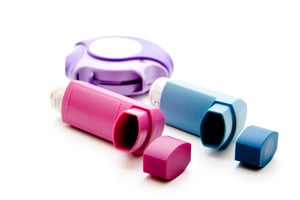Broughton expands analytical testing services with a one-stop solution for Extractables and Leachables
Designing an E&L strategy for pMDI safety
Pharmaceuticals

Jun 7, 2024 | Published by Paul Hardman
Pharmaceuticals
Extractables and leachables (E&L) testing is critical for identifying and quantifying potentially harmful leachable impurities from pharmaceutical container closure systems (CCS) and drug delivery devices. A strong E&L strategy analyses the nature of all present substances and their toxicity, quantifying patient exposure to each chemical and the corresponding risk. Important considerations when designing an E&L strategy include material candidates, study design, and compliance with Good Manufacturing Practice (GMP) standards.
By Paul Hardman, Managing Consultant at Broughton
In the UK, pressurised metered dose inhalers (pMDIs) are a commonly prescribed treatment for the 5.4 million people with asthma and the 1.2 million with chronic obstructive pulmonary disease (COPD). A 2019 study found that based on a sample of 85 patients, switching from dry powder inhalers (DPIs) to pMDIs was associated with decreased asthma exacerbations and improved asthma control. Despite alternatives such as DPIs being available, pMDIs still represent the foundation of asthma control in the UK.
pMDIs consist of a drug formulation (in suspension or solution) with a closure that delivers the required dosage efficiently and consistently. A pMDI usually consists of a pressurised canister that contains the active substance and propellant and is capped with a metering valve, along with a plastic holder consisting of the actuator, mouthpiece, expansion chamber, and mouthpiece.
When using a pMDI, patients administer a precise dose for inhalation into their lungs. Correct administration depends on several factors, including the drug formulation, the device design, and patient technique. For the treatment of lung disease, aerosol droplets must be of a size where they are deposited at their site of action while minimising any deposition on the back of the throat or in the bifurcations of the bronchi. At the same time, any potential toxicants from leachables in the device will also be administered to the lungs, giving potential for alveolar deposition leading to rapid uptake into the bloodstream. Indeed, inhalation aerosols and sprays are classified under USP 1664 as having a high risk of packaging-dosage form interactions. They are evaluated as presenting the highest degree of concern associated with the administration route for considering packaging-associated leachables.
Devising an E&L strategy
E&L studies provide a complete overview of any possible harmful substances that could leach from pMDI packaging. Compared with other pharmaceutical products, pMDIs have a much greater risk of the packaging impacting drug delivery. The formulation includes the API in a hydrofluorocarbon (HFC) liquified gas, which acts as an effective solvent for leaching. Furthermore, pMDIs often consist of multiple materials and plastic components with a range of polymerisation catalysts, antioxidants, pigments, and slip agents used in their manufacture that may leach, all of which may carry varying toxicological risks.
Typically, an E&L assessment starts with a controlled extraction study using various solvents to identify compounds that can be extracted from the packaging. Information gleaned from this is vital for the design of the appropriate leachables studies. Standards and guidelines for pMDI manufacturers to follow during E&L investigations include USP <1663>, USP <1664>, USP <1664.1>, and ISO 10993.
Designing an E&L study
Typically, E&L evaluation is performed during late-stage drug product development. However, it is recommended that manufacturers begin extractables studies early because it can take up to 18 months to be prepared for registration leachables stability assessments. Early assessment allows inappropriate materials to be replaced quicker, reduces risk by allowing time to react to extractables findings, and can help manufacturers accelerate the route to market for their product.
As soon as pMDI manufacturers have identified the material candidates, they can and should investigate their E&L implications. Early consideration of method development and validating bespoke methods for analysing targeted leachables is essential. One key element of method development is ensuring that there is an effective means of ensuring the active pharmaceutical ingredient (API) is cleaned up during sample preparation. Doing so enables consistent and accurate trace analysis, free from interference. Collaborating with E&L specialists with knowledge in this field can help improve turnaround time.
The manufacturer can begin the stability studies after finalising the container closure system design. These include an analysis of the targeted leachables to determine if the identified substances migrate from the container into the drug product and whether there is cause for concern. As well as the targeted leachables, it is best practice to include non-targeted screening methodologies since there is always the possibility that compounds additional to those targeted may arise in the drug product. These include leachable compounds not observed during extractable studies, degradants of identified leachables, and reaction products from the drug product formulation.
Study design can be challenging, so working with an E&L specialist is recommended. These experts can design streamlined, comprehensive studies to capture the necessary data and format it in a way that supports regulatory submissions.
E&L studies allow manufacturers to quantify and analyse harmful chemicals in their drug products and establish patient safety. With pMDIs a cornerstone of asthma and COPD treatment, designing and implementing an effective E&L regime is vital so that these products can reach the market and continue meeting patient needs.
Working with a science or regulatory consultancy can help you design and implement an effective E&L strategy for your inhaled products. To find out more, visit the Broughton website.


